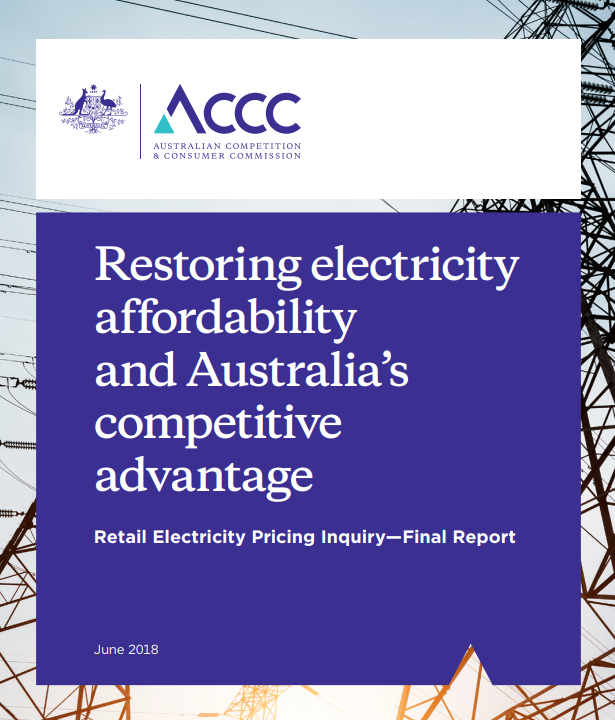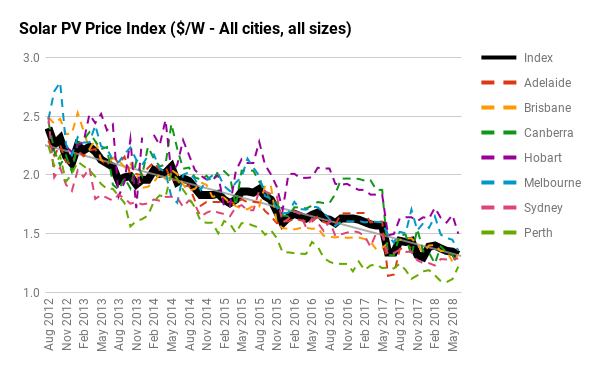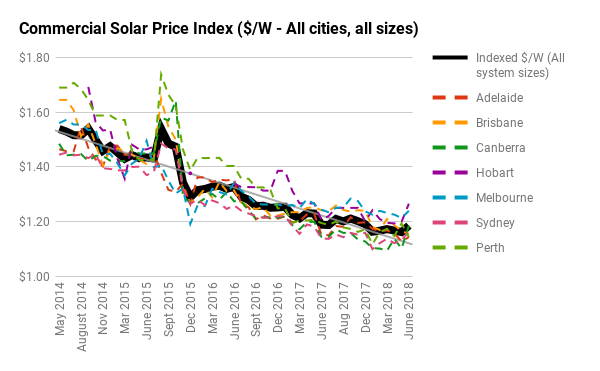 The Australian Competition & Consumer Commission (ACCC) has recommended abolishing the federal incentive for small-scale renewables (like rooftop solar) by 2021 in a ‘blueprint to reduce electricity prices’ – formally called the Retail Electricity Pricing Inquiry report.
The Australian Competition & Consumer Commission (ACCC) has recommended abolishing the federal incentive for small-scale renewables (like rooftop solar) by 2021 in a ‘blueprint to reduce electricity prices’ – formally called the Retail Electricity Pricing Inquiry report.
Eliminating the federal ‘rebate’ could increase the cost of a solar system by around 30%. This would translate into roughly $3,000 more for a typical 5 kilowatt (kW) system. Currently 5kW systems generally cost between $5,000 and $7,000; elimination of the subsidy could see prices soar to $8,000-$10,000 unless component and other costs drop dramatically.
The small-scale incentive (officially known as the Small-Scale Renewable Scheme, or SRES) improves the affordability of solar photovoltaic (PV) system installations by providing an up-front discount on the cost of purchasing a system. It was created to ensure there was a dedicated incentive for small-scale systems (less than 100kW) and is separate from the incentive for large-scale solar systems (100kW or larger), which are eligible for an ongoing incentive in the form of Large-scale Generation Certificates (or LGCs).
Why has the ACCC made this suggestion?
The report was commissioned by the federal government to find ways to reduce soaring electricity prices. The final version, published today, contains a suite of recommendations which the ACCC says would help to reduce annual electricity bills by between about $300 to $750 for residential customers, or $500-$1,500 for small to medium-size businesses. The SRES wold only constitute a very small portion of that savings – about $18 per year.
The table below shows a breakdown of all environmental costs in customer electricity bills, on average across the National Electricity Market and by state, according to the ACCC’s data. On average, the SRES accounts for charges of about $18 per year on the average Australia’s electricity bill.
| Estimated annual contribution of ‘environmental costs’ to electricity bills (as per ACCC report) | |||||||
| VIC | NSW | SA | QLD | TAS | All | ||
| Total environmental costs: | $93 | $109 | $170 | $76 | $155 | $106 | |
|
SRES
|
Percentage of environmental costs | 16% | 17% | 10% | 23% | 20% | 17% |
| Estimated cost | $15 | $19 | $17 | $17 | $31 | $18 | |
|
Feed-in tariffs (legacy)
|
Percentage of environmental costs | 21% | 23% | 43% | 0% | 29% | 23% |
| Estimated cost | $20 | $25 | $73 | $0 | $45 | $24 | |
|
Other state programs
|
Percentage of environmental costs | 14% | 11% | 18% | 0% | 0% | 10% |
| Estimated cost | $13 | $12 | $31 | $0 | $0 | $11 | |
|
LRET
|
Percentage of environmental costs | 49% | 49% | 29% | 77% | 52% | 50% |
| Estimated cost | $46 | $53 | $49 | $59 | $81 | $53 | |
Will the ACCC’s recommendations become policy?
The ACCC’s recommendations are just that – recommendations, not policy – but there is no guarantee that some or all of their suggestions could make it into law under the current government, which is in the process of negotiating the details of the Ultimately, however, the ball is the government’s court whether any of the recommendations should become policy. Even then, any major changes to the SRES – or other schemes – would need to pass through parliament.
The Smart Energy Council quickly came out with a response to the report, calling for the government to rule out the possibility of scrapping the SRES. In a statement, Smart Energy Council chief John Grimes said, “The federal government needs to immediately rule out abolishing the SRES.
“The one thing householders can do to slash their power bills is to install solar. Uncertainty around the SRES will cause unnecessary panic and confusion for consumers and the industry. With massive uncertainty around the future of large-scale renewables because of the design of the National Energy Guarantee, the last thing we need is more uncertainty.”
How much could solar system prices increase if the SRES were eliminated?
Solar Choice publishes average solar system prices for residential & commercial solar systems for each of Australia’s capital cities. Since we started publishing in 2012, we’ve seen system prices drop significantly. The charts below show solar system price trends over the past six years or so.
 Historic residential solar system prices (dollars per watt) – August 2012 to June 2018.
Historic residential solar system prices (dollars per watt) – August 2012 to June 2018.
 Average commercial solar system prices (dollars per watt) – May 2014 to June 2018
Average commercial solar system prices (dollars per watt) – May 2014 to June 2018
This downward trend has been helped significantly by the federal small-scale solar incentive. Even though the incentive has begun to gradually diminish over the past few years (it drops by a small fraction annually), solar has continued to become more affordable – and is now popular and commonplace in Australia, with is a world leader in rooftop solar penetration.
The elimination of the SRES could reverse this long-standing trend. The table below shows how solar system prices could increase if there were no federal incentive for solar. Increase prices would have significant knock-on effects for the financial attractiveness for solar, with payback periods increasing from about 4-6 years to 7-9 years.
| Estimated solar system prices: Current vs no SRES (popular sizes) | |||||||
| System size: | VIC | NSW | SA | QLD | TAS | All | |
|
3kW
|
Current average price | $4,000 | $3,970 | $3,790 | $4,100 | $4,390 | $4,050 |
| No SRES | $5,700 | $6,000 | $5,800 | $6,100 | $6,100 | $6,000 | |
| Potential increase | $1,700 | $2,030 | $2,010 | $2,000 | $1,710 | $1,950 | |
|
5kW
|
Current average price | $5,430 | $5,260 | $4,860 | $5,430 | $6,390 | $5,450 |
| No SRES | $8,400 | $8,600 | $8,200 | $8,800 | $9,300 | $8,700 | |
| Potential increase | $2,970 | $3,340 | $3,340 | $3,370 | $2,910 | $3,200 | |
|
10kW
|
Current average price | $13,560 | $12,310 | $11,820 | $12,160 | $14,420 | $12,850 |
| No SRES | $19,400 | $19,100 | $18,600 | $19,000 | $20,300 | $19,300 | |
| Potential increase | $5,840 | $6,790 | $6,780 | $6,840 | $5,880 | $6,450 | |
|
30kW
|
Current average price | $37,500 | $33,350 | $31,440 | $34,770 | $37,430 | $34,900 |
| No SRES | $55,100 | $53,800 | $51,900 | $55,200 | $55,000 | $54,200 | |
| Potential increase | $17,600 | $20,450 | $20,460 | $20,430 | $17,570 | $19,300 | |
|
50kW
|
Current average price | $61,800 | $59,520 | $59,440 | $60,250 | $61,860 | $60,600 |
| No SRES | $91,100 | $93,600 | $93,600 | $94,400 | $91,100 | $92,800 | |
| Potential increase | $29,300 | $34,080 | $34,160 | $34,150 | $29,240 | $32,200 | |
|
100kW
|
Current average price | $119,660 | $113,640 | $111,600 | $112,280 | $117,600 | $114,950 |
| No SRES | $178,200 | $181,900 | $179,800 | $180,500 | $176,100 | $179,300 | |
| Potential increase | $58,540 | $68,260 | $68,200 | $68,220 | $58,500 | $64,300 | |
Compare Solar & Battery Quotes
- Solar Panel Costs: Solar Choice Price Index | April 2025 - 1 April, 2025
- Solar Panels For Homes – All You Need to Know About Solar Systems - 18 March, 2025
- Best NSW Solar Feed-In Tariffs - 17 March, 2025
We now get 7 cent feed in tariff. If that gets abolished people will take their installations off grid and that will create havoc mid day.
The 7 cents rebate is not the grant, it is what the Electricity retailers are offering.
The Solar industry has been shifted by the other subsidy (RECS) to favour more expensive installations because it’s payment is contingent on Govt approval of particular system designs, and particular suppliers, a system open to not only corruption but also removing most innovation and consumer choice.
Also that Govt, presence needs to be paid for from the system cost.
Now we have a select few retailers and wholesalers lording it over the customers and claiming that they are the only safe way.
In fact, any system has to meet Australian Standards so any Registered Electrician who is prepared to sign off your system to AS 3000 is personally liable for any transgression of that Standard, so is perfectly safe.
All electrical work on premises connected to the National Electricity grid Must meet AS 3000. end of story.
The Grants have introduced a double level of certification, the which increases costs significantly but does nothing else
And where does this leave WA or are we again to be paying for the short-sighted mistake of the eastern states governments when they sold their electricity grid to private companies which are only concerned about maximising profits on their investment?